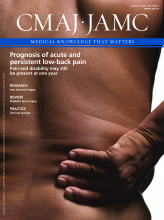Choosing when and how to die
A recent report written for the Quebec National Assembly recommends the introduction of legislation to permit euthanasia. Flegel and Fletcher explore some of the implications of this report and ask if Canada is ready for such a change. See Editorial, page 1227
Prognosis in back pain

Image courtesy of © 2012 Thinkstock
Patients who presented with acute back pain improved markedly in the first six weeks, and by one year, the average levels of pain and disability were low. The initial pattern was similar for patients presenting with persistent back pain, but these patients had moderate levels of pain and disability after one year. These findings are based on a systematic review of 33 cohorts including 11 166 people. Summarizing prognostic factors is a challenge, say the authors, and could be a topic for future research. See Research, page E613
Most of the apparent benefits of treatment for back pain are likely unrelated to the effects of specific interventions, say Buchbinder and Underwood. See Commentary, page 1229
Caring about the health of the poor

Image courtesy of © 2012 Thinkstock
The poor, in general, have worse health than the rich. But there is, in fact, a social gradient of health such that everyone below the very top level of wealth has worse health than those above them. These socioeconomic inequalities in health arise from socioeconomic inequalities in society, including the conditions in which people are born, grow, live, work and age. According to Marmot, social inequality damages social cohesion, which may lead to violence (insecurity), and violates our sense of fairness. See Commentary, page 1231
Iron to treat fatigue
Oral iron reduced the symptoms of fatigue compared to placebo in women with normal hemoglobin but reduced ferritin levels. This randomized controlled trial involving 198 women aged 18 to 53 years also showed effects on blood characteristics related to iron but did not detect a change in global measures of quality of life. Iron deficiency may be an under-recognized cause of fatigue in women of childbearing age, suggest Vaucher and colleagues. See Research, page 1247
Effects of assessing productivity
Strategies for assessing the productivity of faculty in academic medical centres appeared to improve productivity in research and clinical work, but not in teaching, and to lead to increases in compensation. This systematic review summarized findings from eight studies of generally low methodologic quality, all conducted in the United States. Academic departments implementing strategies to assess the productivity of faculty need to consider the associated challenges, uncertainties and intended consequences, say the authors. See Research, page E602
Outcome after childhood brain injury

Image courtesy of © 2012 Thinkstock
After childhood brain injury, relatively good motor outcomes may obscure cognitive and behavioural problems. Widespread views that young brains make better recoveries are naive, say Forsyth and Kirkham. Outcomes after brain injury in children are highly variable. See Review, page 1257
Missing-indicator method for analysis
Although the missing-indicator method is a popular and simple way to handle missing data in clinical research, it has been criticized for introducing bias. According to Groenwold and colleagues, in nonrandomized studies, the factor or test under study is often related to variables with missing values, in which case the missing-indicator method typically results in biased estimates. However, in randomized trials, the distribution of baseline covariates with missing values is likely balanced across treatment groups. This means the missing-indicator method will give unbiased estimates. See Analysis, page 1265
The lost sponge

Image courtesy of © 2012 Thinkstock
The sponge count was incorrect after a laparotomy for suspected small-bowel obstruction in a 43-year-old woman. Despite radiography and exploration of the abdomen, the sponge was not found until after computed tomography and a second laparotomy the next day. What went wrong? How can this type of event be prevented? Grant-Orser and colleagues share the details of this case. See Practice, page 1275











